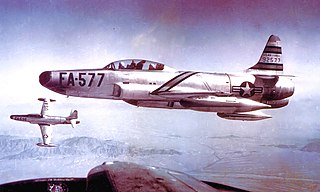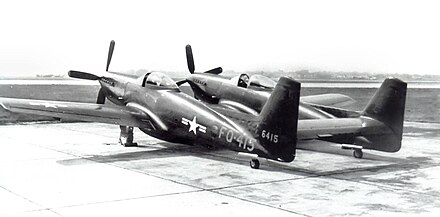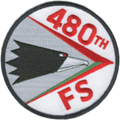
The 414th Fighter Group is an Air Reserve Component (ARC) of the United States Air Force. It is assigned to the 944th Fighter Wing of Tenth Air Force, Air Force Reserve Command, stationed at Seymour Johnson Air Force Base, North Carolina.

The 84th Combat Sustainment Group is an inactive United States Air Force (USAF) group last assigned to the 84th Combat Sustainment Wing at Hill Air Force Base, Utah, where it was inactivated in 2010. The group was formed in 1942 as the 84th Bombardment Group, one of the first dive bomber units in the United States Army Air Corps and tested the Vultee Vengeance, proving that aircraft unsuitable as a dive bomber. As an Operational Training Unit, it was the parent for several other bombardment groups, but from 1943 until it was disbanded in 1944, trained replacement aircrews as a Replacement Training Unit designated the 84th Fighter-Bomber Group.

The 521st Air Defense Group is a disbanded United States Air Force organization. Its last assignment was with the 31st Air Division at Sioux City Municipal Airport, Iowa, where it was inactivated in 1955. The group was originally activated as a support unit for the 310th Bombardment Group at the end of World War II in Italy and then redeployed to the United States where it was inactivated in 1945.

The 567th Air Defense Group is a disbanded United States Air Force organization. Its last assignment was with the 25th Air Division at McChord Air Force Base, Washington, where it was inactivated in 1955. The group was originally activated as a support unit for a combat group at the end of World War II but never deployed before it was inactivated in 1945.

The 4707th Air Defense Wing is a discontinued United States Air Force organization. Its last assignment was with the 26th Air Division of Air Defense Command (ADC) at Otis Air Force Base, Massachusetts where it was discontinued in 1956.

The 4709th Air Defense Wing is a discontinued United States Air Force organization. Its last assignment was with the 26th Air Division of Air Defense Command (ADC) at McGuire Air Force Base, New Jersey, where it was discontinued in 1956. It was established in 1952 at McGuire as the 4709th Defense Wing in a general reorganization of Air Defense Command (ADC), which replaced wings responsible for a base with wings responsible for a geographical area. It assumed control of several fighter Interceptor squadrons that had been assigned to the 52d Fighter-Interceptor Wing, some of which were Air National Guard squadrons mobilized for the Korean War. It also assumed host responsibility for McGuire through its subordinate 568th Air Base Group.

The 568th Air Defense Group is a disbanded United States Air Force organization. Its last assignment was with Air Defense Command (ADC)'s 4709th Air Defense Wing at McGuire Air Force Base, New Jersey, where it was inactivated in 1954. The group was originally activated as a support unit for a combat group at the end of World War II on Guam, but was soon inactivated.

The 82d Operations Group is an inactive United States Air Force unit. It was last assigned to the 82d Training Wing, stationed at Williams Air Force Base, Arizona. It was inactivated on 31 March 1993.
The 4706th Air Defense Wing is a discontinued United States Air Force (USAF) organization. Its last assignment was with the 37th Air Division of Air Defense Command (ADC) at O'Hare International Airport (IAP), Illinois where it was discontinued in 1956. It was established in 1952 at O'Hare as the 4706th Defense Wing in a general reorganization of Air Defense Command (ADC), which replaced wings responsible for a base with wings responsible for a geographical area. It assumed control of several Fighter Interceptor squadrons that had been assigned to the 142d Fighter-Interceptor Wing, an Air National Guard wing mobilized for the Korean War and the 56th Fighter-Interceptor Group. In early 1953 it also was assigned six radar squadrons in the Midwest and its dispersed fighter squadrons combined with colocated air base squadrons into air defense groups. The wing was redesignated as an air defense wing in 1954. It was discontinued in 1956 and most of its units transferred to the 58th Air Division.

The 4708th Air Defense Wing is a discontinued United States Air Force organization. Its last assignment was with the 30th Air Division of Air Defense Command (ADC) at Selfridge Air Force Base (AFB), Michigan, where it was discontinued in 1956. It was established in 1952 at Selfridge as the 4708th Defense Wing in a general reorganization of Air Defense Command (ADC), which replaced wings responsible for a base with wings responsible for a geographical area. It assumed control of several fighter Interceptor squadrons that had been assigned to the 56th Fighter-Interceptor Wing, some of which were Air National Guard squadrons mobilized for the Korean War.

The 518th Air Defense Group is a disbanded United States Air Force organization. Its last assignment was with the 4707th Air Defense Wing, stationed at Niagara Falls Municipal Airport, New York, where it was inactivated in 1955.

The 575th Air Defense Group is a disbanded United States Air Force organization. Its last assignment was with the 4708th Air Defense Wing at Selfridge Air Force Base, Michigan, where it was inactivated in 1955. The group was originally activated as a support unit for the 4th Fighter Group after the 4th returned to the US at the end of World War II and performed that mission until it was inactivated in 1947.

The 528th Air Defense Group is a disbanded United States Air Force organization. Its last assignment was with the 4711th Air Defense Wing at Presque Isle Air Force Base, Maine. It was inactivated on 18 August 1955. The group was originally activated as a support unit for the 97th Bombardment Group at the end of World War II in Italy.

The 564th Air Defense Group is a disbanded United States Air Force organization. Its last assignment was with the 4707th Air Defense Wing, stationed at Otis Air Force Base, Massachusetts, where it was inactivated in 1955. The group was originally activated as a support unit for a combat group at the end of World War II but never deployed before it was inactivated in 1945.

The 519th Air Defense Group is a disbanded United States Air Force organization. Its last assignment was with the 4709th Air Defense Wing, stationed at Suffolk County Air Force Base, New York, where it was inactivated in 1955. The group was originally activated as a support unit for the 485th Bombardment Group at the end of World War II in It/aly and then redeployed to the United States where it was inactivated in 1945.

The 566th Air Defense Group is a disbanded unit of the United States Air Force. Its last assignment was with the 28th Air Division at Hamilton Air Force Base, California where it was inactivated on 18 August 1955. The group was originally activated as a support unit for a combat group at the end of World War II but never deployed before it was inactivated in 1945.

The 325th Operations Group is the flying component of the 325th Fighter Wing, assigned to Air Combat Command of the United States Air Force. The group is stationed at Tyndall Air Force Base, Florida. It conducts training on the Lockheed Martin F-22 Raptor and commands one operational Raptor squadron. It directs the flying and support operations of two F-22 squadrons, a fighter training squadron, an operations support squadron and a training support squadron.

The 527th Air Defense Group is a disbanded United States Air Force organization. Its last assignment was with the 4708th Air Defense Wing at Wurtsmith Air Force Base, Michigan. It was inactivated on 18 August 1955. The group was originally activated as a support unit for the 461st Bombardment Group at the end of World War II in Italy and then redeployed to the United States where it was inactivated in 1945.

The 517th Air Defense Group is a disbanded United States Air Force organization. Its last assignment was with the 4711th Air Defense Wing at Ethan Allen Air Force Base, Vermont. It was inactivated on 18 August 1955.

The 408th Armament Systems Group is an inactive United States Air Force (USAF) unit. Its last assignment was with Air Force Materiel Command's 308th Armament Systems Wing at Eglin Air Force Base, Florida. It was inactivated in 2010.









































